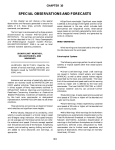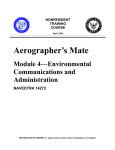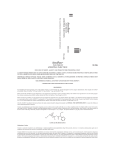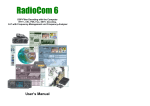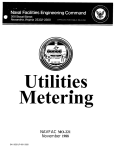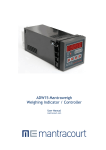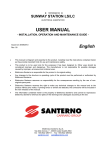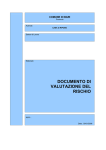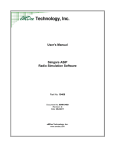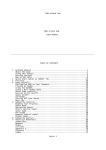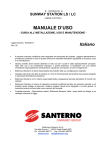Download relinked EO W/ART 01-15-97
Transcript
UNIT 4 METEOROLOGICAL AND OCEANOGRAPHIC PRODUCTS AND THEIR INTERPRETATION FOREWORD Today’s Aerographer’s Mates use vast amounts of meteorological and oceanographic charts and messages. All of these products contain valuable information. The charted products display information with numbers, symbols, lines, and shaded areas on a map background. Messages may either present information in plain language, abbreviated language, code, or alphanumeric plots. As an Airman, you learned how to decode, or interpret, many different types of observation messages while studying to become a Meteorological Technician (Observer/Plotter). As an Aerographer’s Mate Second Class, performing the duties of an Analyst/Forecaster Assistant, and later as an Analyst/Forecaster, you will be required to interpret information presented in many different types of charts and messages. In this unit, we will present information that will help you to interpret the meteorological and oceanographic messages and charts most frequently used by Navy Analyst/Forecasters. In Lesson 1 we will discuss the meteorological and oceanographic models used by the computers at the Fleet Numerical Oceanography Center (FNOC), Monterey, California. In Lesson 2, we will discuss the major meteorological and oceanographic products available from the FNOC computers. The major numerical models in use by the National Weather Service (NWS) and the products available from NWS are discussed in Lesson 3. Lesson 4 addresses the Terminal Aerodrome Forecast Code (TAF). In lesson 5 we discuss products available from the Tactical Environmental Software System (TESS), and the Optimum Path Aircraft Routing System (OPARS) products are discussed in Lesson 6. 4-0-1 UNIT 4—LESSON 1 FLENUMOCEANCEN ANALYSIS MODELS OVERVIEW OUTLINE Identify FLENUMOCEANCEN environmental analysis models and analysis techniques. Surface analysis model Upper-air analysis model Scale and Pattern Separation model Frontal analysis model Tropopause height analysis model Freezing-level analysis model Expanded Ocean Thermal Structure (EOTS) analysis model Thermodynamic Ocean Prediction System (TOPS) Coupled EOTS (TEOTS) analysis model Ocean Frontal analysis model Ocean wave analysis model Sea Surface Temperature analysis model FLENUMOCEANCEN ANALYSIS MODELS Learning Objective: Recognize the impact of grid-point spacing on computergenerated analyses, and identify the parameters and the analysis technique used in FLENUMOCEANCEN’s surface analysis model. There are many computer-generated surface, upper air, and oceanography products available from the FLENUMOCEANCEN. You should be aware of the available products, have an understanding of how they are derived, and how they are interpreted. The heart of computer-generated environmental products is the model or program used to produce the products. Environmental models are used in analyses, prognoses, and special programs, and they are constantly being updated or refined to produce the best possible product. SURFACE ANALYSIS MODEL The FLENUMOCEANCEN surface analysis model produces hemispheric and regional analyses of sea-level pressure, wind, and sea-surface temperature on grids. For example, a hemispheric 4-1-1 analysis is produced on a 63 by 63 grid, and a regional analysis uses a 125 by 125 grid. The first-guess field is also useful in keeping “impossible” observations from being used in the analysis. Grids ASSEMBLY OF NEW IN FORMATION. — In this step, reports of the parameter being analyzed, that is, pressure, wind, etc., are placed at their proper geographic positions on the grid. These observations are then compared to the firstguess values. If an observed value differs from a first-guess value by a pre-set limit, the observed value is termed “impossible” and is thrown out. There is an inherent problem with the assembly step. The majority of the oceans are data sparse. When observations in an area are nonexistent or are termed impossible, the model bases the analysis of the area on the first-guess data field. If the first-guess data field in the area is in error, the analysis ends up in error. Such errors are especially evident when atmospheric changes take place in an explosive manner. For example, if the model does not have an SLP observation(s) in an area undergoing rapid deepening or if it discards a report or reports in an area as impossible, the first-guess values are used. If the first-guess values in the area do not reflect explosive deepening, the area will be incorrectly analyzed. Any incorrectly analyzed region should be brought to the attention of the FLENUMOCEANCEN duty officer in order that the analysis can be corrected. Such corrections often require the insertion of a bogus report(s) into the data field. These made-up reports are designed to correct the analysis in a region in question. Grids come in various shapes and sizes. The grid-point spacing for hemispheric products is equivalent to approximately 320 kilometers, whereas that for regional products is equivalent to 20 to 80 kilometers. The grids used in regional analysis are known as fine-mesh grids. All computer calculations are performed at the grid points, and normally, the closer the gridpoint spacing, the more accurate the analysis, depending on the accuracy of the input data. Each grid-point is assigned a value of the parameter being analyzed. For example, in a sea level pressure (SLP) analysis, each grid point is assigned an SLP. The value assigned to a grid point may be based on past history, current observations, gradient extrapolation, and/or any combination of these three variables. This process is part of the analysis technique used by the model. Fields By Information Blending The surface analysis model currently used by FLENUMOCEANCEN uses an analysis technique known as Fields by Information Blending (FIB). FIB has six component operations as follows: 1. First-guess field preparation of initialization 2. Assembly of new information 3. Blending for the parameter 4. Computing the reliability field of the blended parameter 5. Reevaluation and lateral rejection 6. Reanalysis BLENDING. —Blending is the model step that corresponds to the drawing of isolines by hand. To cover data-sparse regions, grid-point values are adjusted and spread to surrounding grid points using gradient knowledge and mathematical gradient formulation. Blending spreads the data from high reliability grid points (grid points with values based on observations) to those having lower reliability (grid points based on the firstguess analysis). The degree of spreading is increased with higher reliability in the gradient. FIRST GUESS. —The first guess is an estimate of what an analysis will look like without considering current data. It is normally a blend of (1) the previous analysis extrapolated forward to analysis time, (2) a prognostic chart verifying at analysis time, (3) persistence from the previous analysis, and (4) climatology. The first-guess provides continuity in datasparse areas and gives an estimate of the shape (gradients, curvature, etc.) of the data field. In data-sparse areas, the accuracy of a final analysis depends partly upon the first-guess accuracy. COMPUTING RELIABILITY FIELD OF THE BLENDED PARAMETER. —In this step, the computer assigns weight factors to the blended grid-point values. The higher the weight factor, the higher the reliability of the value. For example, a grid-point value based on an observation(s) normally has a higher weight than a grid-point 4-1-2 value based on an extension of a gradient. The reliability of all grid points is increased through the blending process. western Pacific Ocean, Indian Ocean, and the northwestern Atlantic Ocean. The Med and WestPac regions are run at approximately 03Z and 15Z, while the Indian Ocean and NW Atlantic regions are run at 07Z and 19Z. Data from two other regions are also run through the NORAPS program: the Eastern Pacific and the North Pole. However, these two regions are available to the Fleet only upon request. The number and time of NORAPS model runs changes with changing Fleet requirements. REEVALUATION AND LATERAL REJECTION. —In step 5, FIB uses the blended parameter field and the weighted values to reevaluate each piece of information entered into the analysis. Reevaluation is a quality control done on each observation. A statistical value is computed for each report and is compared to the actual value. The statistical value measures how accurate a report really is compared to its expected accuracy as given by its assigned weight factor. The lateral rejection check takes place when each grid-point value, with its weight, is removed individually from the grid and compared with what remains, or the “background.” If the report is within its expected reliability range, no change is made to its weight. If the value is greater than the expected range but within some upper limit, its weight is reduced. If the value exceeds the range limits, the report is rejected (that is, its weight becomes zero) and it has no effect when the next assembly and blending is done. FINE MESH ANALYSIS AND PROGNOSIS. —Fine-mesh products incorporate a terrain disassociation parameter so that values and their gradients do not unduly influence each other on opposite sides of mountains or land features. For example, cold air that piles up on the north side of the Alps does not carry over to the south side. SST analyses for selected regions of the Gulf Stream, Labrador, and Kuroshio currents are conducted using 1/8 size fine-mesh grids. The disassociation parameter is also applied to these analyses, because the temperature structure on opposite sides of peninsulas, etc., can be markedly different. REANALYSIS. —After the grid-point values are reevaluated and new weights are assigned, the reanalysis step begins. This step is no more than a repeat of the assembly step, using the first-guess field and the reevaluated data. The new field may be reevaluated and reanalyzed two or three times before the computer accepts it and sends it to the output section, where it is stored for transmission and for input into other programs. Learning Objective: Identify other models and products to which FIB is applied. FIB Applications The FIB technique is also used with the Navy Operational Regional Atmospheric Prediction System (NORAPS) model. It is applied to FLENUMOCEANCEN’s fine-mesh grids. NAVY OPERATIONAL REGIONAL ATMOSPHERIC PREDICTION SYSTEM. —As of this writing, NORAPS is used in operational data runs to provide 36-hour fine-mesh forecasts for four geographical regions: the Mediterranean Sea, 4-1-3 SPHERICAL SURFACE PRESSURE AND WIND ANALYSIS. —FIB is also used in the construction of the spherical surface pressure and wind analysis. This analysis is produced on a spherical grid every 6 hours. It is a combination of a surface pressure analysis and a wind analysis. The input data include ship reports up to 6 hours old; land reports, with islands receiving more relative weight; low-level satellite winds decreased by 20% of their estimated value (satellite-derived winds are used in the area between 20°N and 20°S only); and coded isobaric analysis messages from various Southern Hemisphere meteorological organizations. The FIB-produced Northern and Southern hemispheres sea-level pressure analyses are interpolated onto a spherical grid, and a firstguess analysis is produced for the regions poleward of 20°N and S. The first-guess pressure analysis is then blended with climatology and the previous spherical pressure analysis to produce a pressure analysis of the region equatorward of 20°N and S. The first-guess wind analysis for mid-latitudes is derived from the surface-pressure analysis; the first-guess wind analysis for the tropics is obtained by blending the previous wind analysis with climatology. A global marine wind analysis is performed to blend the mid latitude and tropical wind fields together. Optimum Interpolation Technique The FIB technique will be replaced in the near future by an Optimum Interpolation (OI) technique. The OI technique is an objective analysis methodology widely used in meteorological and oceanographic applications. It differs from the FIB technique in that it is based upon the concept that the results of the interpolation process must contain the same statistical field properties, that is, time and space statistical structure of variability, independent of the density of observations. Learning Objective: Name the FLENUMOCEANCEN model used to analyze upper-air data and recognize why the program is run every 6 hours. the run. This permits the inclusion of satellite data and aircraft reports, as well as off-time buoy and ship reports. This means that during any single analysis, there can be as much as a 6-hour difference in observations. The program carries the off-time data forward to analysis time. This process is referred to as data assimilation. NOTE The 0600Z and 1800Z upper-air analyses are used as a basis for the 1200Z and 0000Z data runs. They are NOT transmitted to the Fleet. In addition to the NOGAPS-generated spherical upper-air analyses, FLENUMOCEANCEN also produces global band upper-air analyses and southern hemispheric polar stereographic upper-air analyses. Global Band Upper-air Analysis Winds and temperatures are analyzed on a global band grid every 12 hours. The grid is a Mercator projection true at 22 1/2° degrees latitude and extends from 40°S to 60°N. The firstguess field south of 22°N is based on persistence, reverted to climatology. This is primarily due to the sparseness of data over large portions of this region. North of 22°N, NOGAPS upper-air analysis fields are used. UPPER-AIR ANALYSIS MODEL The upper-air analysis model is a subset of the Navy Operational Global Atmospheric Prediction System (NOGAPS). Geopotential heights, temperature, and wind are analyzed for the mandatory levels 1,000 millibars to 100 millibars. Numerous types of data are used in the analysis. Convent ional radiosonde and aircraft reports are used in both the wind and temperature analyses. The wind analysis also includes Pibal reports and satellite derived winds. Vertical temperature profiles obtained from satellite radiometers are used in the temperature analysis. The temperature profiles greatly increase the data base in the Southern Hemisphere. NOGAPS Model NOGAPS is the principal model system in FLENUMOCEANCEN’s operational data runs which begin at 00Z and 12Z. It starts approximately 4 hours into a data run. NOGAPS replaced the Primitive Equation (PE) model as FLENUMOCEANCEN’s primary forecast model in 1982. NOGAPS was last updated in 1986. Southern Hemisphere Polar Stereographic Analysis This analysis uses the same technique as is used in the northern hemisphere upper-air analysis. A major difference is in the amount of satellite data used and the greater weight placed on satellitederived 1,000- to 300-millibar thickness values. NOGAPS upper-air subset is run every 6 hours, even though radiosonde and rawinsonde observations are taken synoptically at 0000Z and 1200Z only. By running the program every 6 hours, off-time observations can be included in 4-1-4 relationships, in the order given above, are Z–SD=SR and SR–SV=SL. Learning Objective: Recognize the most common charts produced using the scale and separation pattern model, and the major problem with the model. To be totally accurate, the amount of smoothing required to remove any one scale should vary depending on the time of year. However, the FLENUMOCEANCEN model employs only the October smoothing value so as not to disrupt component continuity. This results in sL features being somewhat weaker than they should be in summer, and the SD features being somewhat stronger. The reverse is true in winter. SCALE AND PATTERN SEPARATION MODEL The circulation at any level within the atmosphere shows features of varying scale (size) and pattern. At the surface, there are micro-lows, troughs, ridges, migratory cyclones and anticyclones, and the large-scale semi-permanent pressure systems. Aloft, there are troughs, ridges, highs, and lows with varying wavelengths and amplitudes. These in turn are all part of the still larger scale system, the planetary vortex. Interaction of features either at the same level or at differing levels is a major problem faced by synoptic analysts and forecasters. The problem stems from distortion in the circulation patterns caused by the interaction of small-scale and largescale features. The classical example, for instance, occurs in the vertical; the long-wave patterns are distorted by short waves. The distortion makes for subjective positioning of the long-waves, and the positions are usually inaccurate. An inaccurate analysis then leads to inaccurate prognoses. To overcome such subjective determinations, the scale and separation model was developed. The scale and separation model provides an objective measure of scale while retaining characteristic recognizable patterns. It separates features of various size into separate parts. For example, it takes the 500-millibar field and separates it into a short-wave field (500-millibar SD), a long-wave field (500-millibar SL), a residual field (500-millibar SR), and a planetary vortex field (500-millibar SV). The model uses a smoothing process to separate each field. For example, if the small-scale features (SD) are smoothed out of the total field (Z), a residual field (SR) remains. The residual field contains the largescale disturbance features (SL) and the planetary vortex (SV). The SR field at 500 millibars is ideal for locating long-wave troughs. A more massive smoothing process continues on the residual (SR) field until only the planetary vortex remains. The large-scale disturbance pattern is obtained by subtracting the planetary vortex field from the residual field (SL = SR – SV). The smoothing Learning Objective: Recognize the parameter used in FLENUMOCEANCEN’s atmospheric frontal model and the strengths and weakness of the final product. FRONTAL ANALYSIS MODEL The most desirable aspect of the FLENUMOCEANCEN frontal analysis model is its objectivity. The fact that mean potential temperature is the only parameter used to determine frontal positions makes it very objective. Potential temperatures are obtained by calculating the 1,000- to 700-millibar thickness field and converting the thickness to the mean potential temperature of the 1,000-to 700-millibar layer. The program then computes the gradient of the mean potential temperature gradient (GG). A GG analysis accurately marks the division between two air masses having different thermal structures. The least desirable aspect of the frontal analysis model is its overall accuracy. Large grid size, and the possible inaccuracy of upper-air temperature analyses over data-sparse areas precludes frontal positions from being more accurate than ± 100 miles. The program also has a few other weaknesses, as follows: Ž It may indicate fronts in mountainous regions when no fronts exist. 4-1-5 Ž It handles occlusions poorly, because of the lack of thermal contrast across occluded fronts. Ž It handles fast-moving cold fronts poorly, because the major temperature contrast occurs well behind the front. Ž It produces false frontal indications in regions where fast-forming strong inversions develop. For all the above reasons, CG frontal analyses should NOT be used as the final determination in positioning fronts. We recommend that you use the CG analysis as a first guess or simply as a guide in your analysis procedure. You should analyze as many frontal placement parameters as possible before settling on your final frontal positions. Learning Objective: Recognize how FLENUMOCEANCEN models derive the heights of the tropopause and the freezing level. FREEZING LEVEL MODEL The freezing-level model interpolates the freezing level from the temperatures reported at the mandatory constant-pressure levels. Starting at 1,000 millibar, the computer checks the temperature at each mandatory level until it encounters the first level with a temperature below 0°C. The model uses this level and the one preceding it to interpolate the freezing level. There are some problems associated with this linear interpolation process. It does not account for the following: (1) poor constant-pressure height and/or temperature analyses, (2) inversions, or (3) multiple freezing levels. Even with the above limitations, interpolated heights are normally within 100 feet of observed values. The freezing-level chart is widely used in aviation forecasting. It is used to outline areas of potential aircraft icing, and in thunderstorm forecasting. The most severe icing occurs at temperatures between 0°C and –10°C. With regard to thunderstorms, lightning strikes are most prevalent at the freezing level. Pilots must be advised of this when their aircraft is cleared through a thunderstorm area. Freezing-level charts are also used to forecast changes from rain to snow and vice versa. Learning Objective: Identify FLENUMOCEANCEN oceanographic analysis models and their uses. TROPOPAUSE HEIGHT-ANALYSIS MODEL The tropopause is defined by characteristic changes in the temperature lapse rate. In computing the height of the tropopause, the FLENUMOCEANCEN model combines the lapse rate between the 500- and 400-millibar levels extrapolated upward and the lapse rate between 150- and 100-millibar level extrapolated downward. The height of the tropopause is found at the point where the two lapse rates intersect. This level averages out to be 700 feet below the observed tropopause. A 5-year evaluation period of the above method also showed that, on the average, the level of maximum winds (in the jet core) is found 2,300 feet below derived tropopause heights. The model incorporates a 3,000-foot constant to account for the 700- and 2,300-foot deviations. This means a tropopause height chart actually represents the level of maximum winds. The true tropopause height is 3,000 feet higher than indicated on the chart. EXPANDED OCEAN THERMAL STRUCTURE (EOTS) ANALYSIS MODEL The EOTS model is used to produce temperature versus depth (surface to bottom) analyses, Sea Surface Temperature (SST) analyses, and layer depth analyses. EOTS provides the input for most of the acoustic predictions generated at FLENUMOCEANCEN. Data Input The daily real-time global data base used by EOTS consists of 150 to 200 XBT observations, 1,200 to 2,000 SST observations (ship injection or bucket), and 50,000 to 80,000 satellite SST readouts. 4-1-6 EOTS can also accept synthetic data inputs such as horizontal surface and subsurface thermal gradients. The regional centers supply the synthetic data in message form. and seas occur over an area of the ocean from which little or no ocean thermal data is received, and atmospheric conditions are NOT considered, EOTS uses the climatological mean of the layer depth in the area. In such a case, the LD would be too shallow for the existing conditions. The TEOTS model is run once every 24 hours and is coupled to TOPS in cyclical fashion. The analysis system is exacting the same as EOTS, except for the coupling procedure and a different prescription of certain tuning parameters. Like EOTS, the FIB technique is used to combine the various types of data. TEOTS is used to produce ocean temperature versus depth profiles and PLD analyses for oceans of the Northern and Southern hemispheres and for individual seas, that is, the eastern and western Mediterranean Sea and the Norwegian Sea. Analysis EOTS analyzes 26 thermal parameters in the upper 400 meters of the sea on a 63 by 63 or 125 by 125 vertical grid. Below 400 meters, the thermal field is derived from climatology and is modified to blend smoothly with the temperature profile analyzed above 400 meters. The primary layer depth (PLD) is the first parameter analyzed by the model. This is generally the depth of the seasonal thermocline. The remaining 25 parameters are temperatures and vertical temperature derivatives. They are analyzed at fixed and floating (fluctuating) levels. The floating levels are relative to the PLD: PLD-25 meters, PLD + 12.5 meters, PLD + 25 meters and PLD + 50 meters. Consequently, when the PLD changes, so do the floating levels. FIB methodology is the heart of the EOTS analysis. A three-cycle FIB technique is used to analyze the fixed- and floating-level temperatures on a horizontal plane and to analyze the vertical temperature gradients between the fixed levels. These analyses are based purely on information blending techniques. EOTS does not consider the effect of oceanic physics and air-sea interaction processes. Learning Objective: Identify the primary elements used in FLENUMOCEANCEN’s ocean frontal analysis model. OCEAN FRONT ANALYSIS MODEL Ocean fronts separate water of different physical, chemical, and biological properties. Ocean fronts are much like atmospheric fronts in that (1) they move, but are much slower than atmospheric fronts; (2) they may be sharply defined or difficult to locate; (3) segments may be quasi-stationary; and (4) intensity changes occur with time. Prior to the ocean frontal model being developed, a large number of oceanic parameters were tried and tested to see which parameters would provide the best analysis. Salinity and biological parameters were not even considered, because of the lack of synoptic data. When all the testing was complete, FLENUMOCEANCEN settled on surface and subsurface temperatures as the parameters it would use. Like numerical atmospheric frontal analysis, a GG operator is used to describe oceanic fronts. It is applied to fine-mesh SST analyses and to finemesh subsurface temperature analyses. The latter are obtained in the ocean thermal structure analyses performed by EOTS. Frontal analyses based on fine-mesh SST fields are considered very reliable. Frontal analyses Learning Objective: Identify the model that couples EOTS with atmospheric processes. TOPS-COUPLED EOTS (TEOTS) ANALYSIS MODEL The coupling of ocean thermal analyses to atmospheric forces is accomplished via the physics incorporated in the Thermodynamic Ocean Prediction System (TOPS) model. The coupling prevents mixed-layer depths and mixed-layer temperatures from following strictly climatological trends. For example, consider a rapidly deepening low-pressure system with strong winds and heavy seas. Such a system normally produces strong mechanical mixing, which in turn produces deeper layer depths. However, if the strong winds 4-1-7 based on subsurface thermal fields are NOT considered to be overly reliable, because subsurface data inputs are drastically sparse. You should be aware of which field is used for input and know the locations of the observations used to make the field in order to evaluate the reliability of any ocean frontal analysis. OCEAN WAVE ANALYSIS MODEL Ocean wave analysis is conducted numerically using the Global Spectral Ocean Wave Model (GSOWM). This model came into existence in 1985 and replaced the older Spectral Ocean Wave Model in all areas except the Mediterranean Sea. GSOWM functions are performed on the standard FLENUMOCEANCEN 2.5° latitude by 2.5° longitude spherical grid in a global band extending from 77.5°N to 72.5°S. GSOWM directional wave spectra is used to derive the following output fields: significant wave height, maximum wave height, whitecap probability, and primary and secondary wave direction and period. These fields are transformed to a variety of map projections. 4-1-8 Learning Objective: Identify the model used to produce SST analyses. SEA-SURFACE TEMPERATURE ANALYSIS MODEL Any of the environmental models maybe used to produce analyses and prognoses for ocean waves, sea-surface temperature, and ocean thermal structure. Most often, the Navy Operational Regional Prediction System (NORAPS), is used to produce regional SST analyses. The reported sea surface temperatures from ships, satellite reports, and climatology are weighted and combined for a data field. The data is then evaluated in a similar manner as any other data in the surface analysis routine. SUMMARY In this lesson we have discussed some of the analysis techniques used by the computers at FLENUMOCEANCEN. This information has been discussed so that you, the analyst, will have a basic knowledge of the strengths and weaknesses of the computer analyses you will be using. With this knowledge, you will be able to make informed adjustments to information depicted in FLENUMOCEANCEN’s computer analyses. UNIT 4—LESSON 2 FLEET NUMERICAL OCEANOGRAPHY CENTER METEOROLOGICAL AND OCEANOGRAPHIC PRODUCTS OVERVIEW OUTLINE Identify and interpret major meteorological and oceanographic products produced and issued by the Fleet Numerical Oceanography Center. Surface weather charts Upper-air charts Freezing-level charts Oceanographic charts Message products Acoustic Range Prediction Products (NOAA) activities, receive FNOC charts and products via the joint Navy/NOAA Oceanographic Data Distribution System (NODDS). This system allows charts and products to be received on desk-top computers using a telephone modem. The major benefit derived from computergenerated charts is the time saved by not having to plot and analyze the data. A major problem with these charts is that analysts and forecasters work from finished products, and do not analyze the observations used to produce the charts. A great deal of meteorological insight is lost when weather observations are not studied. Fleet requests for products are sent to FNOC over the AUTODIN or NEDN communications networks, using the Automated Products Requests (APR) format. FLEET NUMERICAL OCEANOGRAPHY CENTER METEOROLOGICAL AND OCEANOGRAPHIC PRODUCTS The Fleet Numerical Oceanography Center (FLENUMOCEANCEN or FNOC) Monterey, California, produces computer-generated meteorological and oceanographic charts and messages for use by Naval Oceanography Command (NOC) units, the Navy, and the Department of Defense. The data from which meteorological and oceanographic charts are derived is transmitted from FNOC to NOC Centers via the Naval Environmental Data Network (NEDN) to Naval Environmental Display System (NEDS) terminals. The NEDS units (AN/FMC-l) store the data. NEDS operators are then able to produce the charts on their NEDS terminals, They are also able to transmit any or all of this data to NOC facilities and/or detachments having a NEDS-1A unit (AN/FMC-2). The centers can also include these charts as part of their facsimile transmission schedule to the Fleet. Many Department of Defense users other than the Navy, and other U.S. Government agencies, such as the U.S. Coast Guard and National Oceanic and Atmospheric Administration Learning Objective: Interpret various surface weather charts produced by FNOC. SURFACE-WEATHER CHARTS Manually prepared surface-weather charts are quite different from the computer-generated 4-2-1 surface-weather charts. At the very least, manually produced surface charts will include weather station plots, isobars, and fronts. A more in-depth chart may contain a nephanalysis (cloud analysis), air mass designators, and a weather depiction analysis. At their best, manually produced surface-weather charts are highly colorful and extremely informative. Computer-generated surface charts do not contain nearly as much information as the manually produced charts. They do provide an isobaric analysis; they may or may not include weather station plots or low-level-wind plots; and they do not contain fronts. Fronts must be handdrawn on these charts. Surface-Weather Analysis Charts Synoptic charts of surface pressure, wind, and frontal analysis are produced every 6 hours, beginning at 0000Z. An example of an FNOC surface-pressure preliminary analysis (SFC PRELIM) is shown in figure 4-2-1. This chart covers about an eighth of the globe and provides an initial look at the pressure systems. Highly smoothed isobars are drawn every 4 millibars (hectopascales), High- and low-pressure centers are indicated by H and L, with the exact center Figure 4-2-1.-Surface preliminary analysis. 4-2-2 indicated by a “+” mark. The central pressure is printed to the right of the “+” mark in tens, units, and tenths of millibars. Shortly after the SFC PRELIM is produced, the computers complete the more detailed surface pressure and surface wind analyses. These two analyses are transmitted to users over the NEDN as separate data fields, and then are combined at a NEDS terminal to produce a composite chart. Figure 4-2-2 shows a more detailed combined surface wind and pressure analysis, a Global Band tropical analysis. This Mercator map projection is typical of charts produced for users in the tropics. Note the smaller scale; this chart covers only about one-fifteenth of the globe. The isobars are drawn every 4 millibars. They show a much more detailed representation of the pressure pattern than is shown in the SFC PRELIM analysis, although smoothing may eliminate minor, yet significant pressure deviations. Winds are represented on this chart by standard wind plots on a five-degree grid. They do not represent actual reported winds, but computer-averaged winds over a five-degree-square area. Neither of the FNOC surface analyses depicts fronts or troughs. Figure 4-2-2.-Surface-wind and surface-pressure analysis. 4-2-3 The frontal depiction analysis (GG-Theta) is shown in figure 4-2-3. This example is an analysis from central Asia to central North America. The frontal positions are depicted with contours of percent probability of the frontal location. It is up to the user to determine the actual frontal placement, as well as the type of discontinuity— warm front, cold front, occlusion, or pressure trough. This analysis does not always provide the user with clear-cut frontal boundaries. Normally, fronts are located where the isolines are packed tightly around an elongated central core. The isolines parallel all fronts except occluded fronts. The isolines lie more or less perpendicular across occlusions. Usually, the higher probabilities surround areas where reports show strong discontinuities, such as large temperature changes, large wind speed and direction changes, or marked pressure rises and falls. The higher probability areas tend to indicate the locations of the more dynamic fronts. Notice in the tropical portion of the example (fig. 4-2-3) that several areas are surrounded by only 10-percent-probabilit y contours. These areas indicate that the computer has found only minor discontinuities. A minor discontinuity maybe a pressure fall or a wind shear line indicating a tropical wave. In the mid-latitudes, the lower probability contours may indicate a pressure trough or a very weak, non-weather-producing frontal position. While you may infer frontal intensity (weak, moderate, or strong) from this chart, you would need to compare this chart to previous charts to infer frontal type (cold, warm, occluded) and frontal character (undergoing frontogenesis, undergoing frontolysis, or having no change). Surface-Weather Prognostic Charts Surface prognostic charts, or forecasts of the surface pressure, surface wind, and frontal depiction, are produced every 12 hours, beginning at 0000Z. Surface-pressure prognoses are available out to 120 hours (5 days). Figure 4-2-4 shows a typical surface-wind and surface-pressure prognosis. Winds and pressure are depicted the same as on the analysis charts. Frontal depiction prognosis charts are produced to match the area and map projection of the surface prognosis charts. This polar stereographic map projection example (fig. 4-2-4) is typical of most of the charts produced for the mid-latitude users. The winds are plotted on a grid with spacing between grid points of about 5 degrees latitude at 15°N, or about 300 nmi. As you look farther north, you Figure 4-2-3.-Frontal depiction analysis. 4-2-4 may notice that the same grid spacing is equivalent to about 7 degrees latitude at 50°N, or about 420 nmi. This means that at 15°N the wind plot represents an average wind for a 90,000-squaremile area, while at 50°N the wind plot represents an average wind for a 176,400-square-mile area, or about one-half the resolution. You must keep that in mind when using these charts to make your forecast. Sometimes it is preferable to use a geostrophic wind scale and isobar spacing to determine forecast winds, instead of the winds plotted on the chart. Learning Objective: Interpret FNOC constant-pressure and freezing-level charts. UPPER-AIR CHARTS The upper-air analyses and prognosis charts are all very similar. Analyses are routinely produced for the 850-, 700-, 500-, 400-, and Figure 4-2-4.-Surface-wind and surface-pressure prognosis. 4-2-5 300-, and 200-millibar levels. Figure 4-2-5 shows an 850-millibar analysis on a polar stereographic map projection as used in the mid-latitudes. Figure 4-2-6 shows a 500-millibar, 48-hour prognosis. Except for the chart identification and contour labeling, these charts are very similar. The winds, temperature, and height prognosis data fields are usually combined on a single chart for each of the various constant-pressure surfaces. Winds are represented with standard plots; height contours (isoheights), by solid lines; and temperature (isotherms), by dashed lines. All charts use a 5°C isotherm interval, with the temperatures labeled in degrees Celsius. The 850-millibar chart uses a 30-meter isoheight interval; the 700- and 500-millibar charts use a 60-meter isoheight interval; and the 400-, 300-, and 200-millibar charts use a 120-meter Figure 4-2-5.-850-millibar analysis. 4-2-6 Figure 4-2-6.-500-millibar prognosis. isoheight interval. While the 500-millibar level is routinely available in 12-hour increments out to 120 hours, and the other levels are routinely available in 12-hour increments out to 72 hours, the charts transmitted on the Fleet Facsimile broadcasts are usually limited to the 24- and 48-hour forecasts. Generally, products distributed to the fleet are tailored by the NOC centers. FREEZING-LEVEL CHARTS The FNOC computers calculate the freezing level during the analysis and during the forecast model runs. Freezing-level analyses and 4-2-7 prognostic data fields are produced routinely twice a day out to 72 hours. Figure 4-2-7 shows a typical freezing-level prognostic chart. Solid lines depict only the lowest freezing level. The contour labeled 00 indicates the freezing level at the surface. Additional contours are depicted every 500 meters, and labeled in hundreds of meters. Since flight weather briefs require freezing levels in feet, the user must convert the heights in meters to feet. Always be alert for signs of multiple freezing levels. The most dangerous aircraft icing, severe clear ice, can occur when liquid precipitation falls into a layer of freezing air. Precipitation in areas with multiple freezing levels may indicate severe clear icing. This chart will not indicate those situations properly. Besides producing meteorological analyses and forecast charts, FNOC also produces many oceanographic charts. Several of these oceanographic charts are discussed in the next section. Learning Objective: Interpret various oceanographic charts produced by FNOC. OCEANOGRAPHIC CHARTS The oceanographic charts produced by the computers at FNOC provide analyses and forecasts of conditions that directly effect daily operations in the Navy’s antisubmarine warfare effort, as well as routine ship operations. Computer interface with the climatological data base and with data files of current and near-current oceanographic observations allows development of a Figure 4-2-7.-Freezing-level prognosis. 4-2-8 much more accurate depiction of oceanographic features than is possible by a single oceanographic analyst/forecaster. However, over-smoothing of the data fields on the largescale charts routinely transmitted via facsimile may mask significant details necessary for certain applications. Products transmitted over the unencrypted facsimile broadcast may be intentionally over-smoothed so as not to yield details of significant oceanographic features to nonNATO naval forces who routinely intercept and use the data from the broadcast. For applications requiring greater accuracy and detail, the Automated Product Request (APR) system should be used to receive oceanographic products via encrypted channels. In this section we will discuss the Sea Surface Temperature analysis, the Sea Surface Temperature Anomaly analysis, the Significant Wave Height analysis and prognosis, the Mixed Layer Depth analysis and prognosis, and the Sonic Layer Depth analysis charts. All of these products are routinely available on Mercator projections or as polar stereographic-map projections in a wide range of map scales. The examples provided in the text are generally the larger scale map projections. Sea Surface Temperature Analysis The sea surface temperature analysis shown in figure 4-2-8 is typical of the low-resolution Figure 4-2-8.-Sea surface temperature analysis. 4-2-9 product transmitted via the facsimile broadcast. Solid lines are used to depict sea surface temperature isotherms every 4°C. A similar, medium-resolution chart is also transmitted that uses a 2°C isotherm interval. Very small scale, high-resolution charts are available on the NEDS that which use a 1°C interval or less. Sea Surface Temperature Anomaly Analysis The sea surface temperature anomaly chart depicts areas that are warmer or cooler than the climatic normal for the month. Areas enclosed with an isotherm that show a negative temperature are colder than normal. The example shown in Figure 4-2-9.-Sea surface temperature anomaly analysis. Figure 4-2-10.-Significant wave height (hemispheric) analysis. 4-2-10 figure 4-2-9 is a Mercator hemispheric projection that uses a 2°C contour interval. Regional analyses are also available that use a 1°C isotherm interval. Significant Wave Height Analysis and Prognosis The significant wave height (SIG WAVE HT) analysis and prognosis charts are very useful for daily shipboard sea state forecasting, heavy weather avoidance, and Optimum Track Ship Routing. Figure 4-2-10 shows a typical lowresolution hemispheric analysis. Figure 4-2-11 shows a typical regional prognosis. The hemispheric analysis uses a 6-foot wave height contour interval starting at 12 feet; the regional analyses and forecasts use a 3-foot contour interval beginning at 3 feet. The significant wave height charts do not specifically show wind wave heights or swell wave heights. It shows computer calculations of the significant (highest one-third) of the sea waves (waves produced by the local winds) based on the fetch and duration from the analyzed and forecast surface wind fields. It will not indicate the swell waves, which may at times be higher than the sea waves. It also does not indicate a prevailing wave Figure 4-2-11.-Significant wave height (regional) prognosis. 4-2-11 direction, although this may be inferred by comparing the SIG WAVE HT charts to the corresponding surface wind charts; the primary wave direction should be the same as the direction the wind is blowing towards. Remember, though, that wind directions are reported as the direction the wind is coming from; wave directions are reported as the direction the waves are moving to. Most of the Fleet Facsimile Broadcasts also include charts, manually produced at the Oceanography Centers, that include swell wave heights. These are the Combined Sea Height charts. The combined sea height is actually the highest wave height at the points where the significant sea waves merge with the swell wave. Where these waves meet, a higher wave is formed than either the highest sea-wave height or the highest swell-wave height alone. The combined sea height, C, is calculated from both the sea-wave height (either the reported significant sea-wave height or the computer-calculated significant seawave height) and the swell wave height by the formula The combined sea height charts also indicate the prevailing wave direction with an arrow. It is important that you know the differences between the combined sea height chart and the significant wave height chart. They are not intended to show the same parameters and should rarely look exactly alike. Comparison of both types of charts for corresponding times will give you a good overall picture of the swell wave, the sea waves, and the general sea state. Mixed Layer Depth Charts The mixed layer depth (MLD) analysis chart shown in figure 4-2-12 depicts the depth of the mixed layer, in meters. Contours are drawn on the hemispheric chart at 10, 20, 30, 45, 60, 80, 100, 140, 180, 230, and 280 meters. The deeper the mixed layer, the larger the contour interval. The MLD is the bottom of the uppermost layer of the ocean, the Mixed Layer, which, because of mixing by waves and currents, is usually fairly isothermal or shows only a slightly negative temperature gradient with depth. The MLD is also considered the top of the second ocean layer, the Main Thermocline, where the temperature decreases rapidly with depth. Because of the sharp decrease in the temperature gradient with depth at the MLD, the MLD usually, but not always, is the point of maximum sound velocity in the upper 1,500 feet of the sea. In the cases where the MLD is the point of maximum sound velocity, it is also known as the Sonic Layer Depth (SLD). Figure 4-2-12.-MLD analysis. 4-2-12 Prognostic charts of the forecast change in the MLD are available in addition to the analyses. Figure 4-2-13 shows a full hemisphere (Northern) polar stereographic projection of the 24-hour forecast changes in the MLD, which are due to increasing or decreasing wave heights. The contours are in meters, with a 4-meter interval. Negative values indicate an increasing MLD (the MLD becomes deeper); positive values indicate a decreasing MLD. Figure 4-2-13.-MLD change prognosis. 4-2-13 Sonic Layer Depth Analysis The Sonic Layer Depth (SLD) analysis chart as shown in figure 4-2-14 on a Mercator map projection uses shading instead of contours to indicate the depth of the maximum speed of sound near the surface. The different types of shading indicate ranges of the SLD in feet: no horizontal shading lines (clear) indicate an SLD between the surface and 50 feet; widely spaced horizontal lines (light) indicate SLD depths between 50 and 100 feet; closely spaced lines (medium) indicate depths from 100 to 350 feet; and very closely spaced lines, forming the darkest (heavy) shading, indicate depths deeper than 350 feet. Since the SLD may coincide with the MLD as deep as 1,500 feet, the MLD analysis, which contours down to 280 meters (about 900 feet), may be more useful for many applications. Reanalysis of this chart by drawing in the 50-, 100-, and 350-foot contours makes it a better briefing tool and equates roughly to the 15-, 30-, and 100-meter contours on the MLD analysis, FNOC also produces this chart with the contours in feet vice meters. You have seen a few of the charts that are available for oceanographic applications on many different map projections and scales. The basic presentation of features on these charts are all very similar, regardless of the resolution used. Just about every data field that is presented in chart form is also available as a message of gridded point values, which may be transmitted over various communications circuits to suit your requirements. Figure 4-2-14.-SLD analysis. 4-2-14 The NAVOCEANCOM Environmental Tactical Support Products Manual (U). Request procedures are found in the Automated Product Request (APR) User’s Manual. Learning Objective: Identify the sources to obtain information on the request procedures for message format gridded data fields. ASRAP Products ASRAP is an omni-directional product that provides the tactician with expected acoustic ranges for user-specified or default-source depth/receiver, depth/frequency combinations. This product supports all aircraft and surface ship passive sonar systems and is available in four modes: MESSAGE PRODUCTS AWSP 105-52, volume III, Weather Message Catalog, lists MANOP headers for many predesignated FNOC meteorological and oceanographic products in gridded format, ranging from surface winds and upper-level winds to highly detailed sea-wave spectrum predictions for specified points. In addition, Automated Product Request (APR) User’s Manual, FLENUMOCEANCENINST 3140.3, describes procedures for requesting various data fields and specialized meteorological and oceanographic products. A new instruction, General Acoustic Conditions Depiction System User’s Guide, FLENUMOCEANCENINST 3145.3, describes various acoustic-conditions graphic products, as well as alphanumeric gridded products available from FNOC via NEDS, NODDS, and AUTODIN message. Ž ASRAPC—Frequency Mode; the various source depths and receiver depths are depicted for each frequency. Ž ASRAPR—Receiver Mode; the various frequencies and source depths are depicted for each receiver depth. Ž ASRAPS—Source Mode; the various frequencies and receiver depths are depicted for each source depth. Ž ASRAPV—VLAD Mode; for use with the Vertical Line Array DIFAR (VLAD) sonobouy. ASRAP one-way propagation-loss information is also applicable to shipboard passive sonar systems. This product is primarily used by the VP squadrons. Learning Objectives: Identify the Acoustic Range Prediction products available from FNOC; identify the manual that describes the request procedures for the products; and identify the manual that describes the product format and interpretation guide. Active ASRAP Products ACOUSTIC RANGE PREDICTION PRODUCTS FNOC provides acoustic range prediction products in support of active and passive sonar systems. The Acoustic Sensor Range Prediction (ASRAP) and the Predesignated High Interest Tactical Area (PHITAR) products were developed to support passive systems. Active systems are supported by the Active ASRAP and the Ship/Helicopter Acoustic Range Prediction System (SHARPS) products. Although briefly described in this section, these products and their applications are thoroughly described in the classified NAVOCEANCOMINST C3140.22, The Active ASRAP product was developed to support active airborne sonar systems. This product supports the SSQ-47, SSQ-50, and SSQ-62 active sonobouys. Range predictions are provided for different system modes and source/receiver depth combinations which may be user-specified. The product is used by both VP and carrier based ASW squadrons, as well as by surface combatants. SHARPS Products SHARPS was developed to support shipboard and helicopter active sonar systems, but now includes support for the passive mode as well. This product may be fully tailored using specified sonar parameters for individual ships. The product 4-2-15 displays a 50-percent probability of detection range as a function of sonar mode, ship’s speed, and transmission path (direct, convergence zone, and bottom bounce). Estimated passive and active counter detection ranges are also provided. PHITAR Products PHITAR primarily provides propagation-loss data to submarines in a communications efficient form, although it is also used by air and surface ASW squadrons. It is available in three modes: Ž PHITAR—Receiver Mode; the various frequencies and source depths are depicted for each receiver depth. Ž PHITARF—Frequency mode; the various source depths and receiver depths are depicted for each frequency. Ž PHITARV—VLAD Mode; used with the VLAD sonobouy. PHITAR propagation-loss data is used by the requestor to plot propagation-loss (proploss) 4-2-16 curves and thereby determine expected passive acoustic ranges for the sonar systems of interest, Because of the sensitivity of the information contained in the actual Acoustic Range Prediction products, we cannot present meaningful examples of each product or provide a breakdown of the message format. To properly interpret these products, you should consult NAVOCEANCOM Environmental Tactical Support Products Manual. SUMMARY In this lesson we have discussed a few of the most widely used products available from the U.S. Navy’s Fleet Numerical Oceanography Center. Many specialized computer produced products are available for your use that we have not even mentioned. You should take the time some quiet mid-watch to look through APR User’s Manual, General Acoustic Conditions Depiction System Users Guide, and if you have the required clearance, through the NAVOCEANCOM Environmental Tactical Support Products Manual to familiarize yourself with some of the other computer-produced products available. UNIT 4—LESSON 3 NATIONAL WEATHER SERVICE CHARTS AND PRODUCTS OVERVIEW OUTLINE Identify the types of National Weather Service products and the routine methods used to distribute these products to Naval Oceanography Command and Fleet Aerographer’s Mates. General types of National Weather Service products Availability of NWS products to Naval Oceanography Command units Availability of NWS products to Fleet Aerographer’s Mates Informational sources about NWS products, availability, and schedules Identify the major numerical prediction models used by the National Weather Service. Numerical prediction models used by the National Weather Service Identify parameters on the most frequently used National Weather Service facsimile charts. Parameters on NWS facsimile charts Surface analysis Weather depiction analysis Radar Summary analysis Upper-air analysis Composite analysis 12-hour upper wind forecast 12- to 48-hour Boundary Layer wind forecast 12- to 48-hour surface weather forecast series NGM 12- to 48-hour forecast series MOS probability forecast Mid-range surface forecast Mid-range temperature forecast Interpret commonly used National Weather Service bulletins. Interpretation of frequently used coded bulletins NATIONAL WEATHER SERVICE CHARTS AND PRODUCTS branch of the National Oceanic and Atmospheric Administration (NOAA), under the U.S. Department of Commerce. The National Weather Service computers at the National Meteorological Center (NMC) in The National Weather Service (NWS), headquartered in Suitland, Maryland, operates as a 4-3-1 Suitland are the focal point for meteorological data collection in the United States. As a member of the World Meteorological Organization (WMO), NWS also shares selected data and products with all other member nations in the WMO via the WMO data collection computer system based in Geneva, Switzerland. Learning Objective: Identify the types of National Weather Service products and the routine methods used to distribute these products to Naval Oceanography Command units and Fleet Aerographer’s Mates. GENERAL TYPES OF NATIONAL WEATHER SERVICE PRODUCTS Most of the observational and prognostic data routinely received from foreign countries by NWS is in the form of digital messages, although some digital charts are received. The National Weather Service computers at the National Meteorological Center (NMC) automatically receive and process all data received from North America and the remainder of the world. Selected raw observational data is routinely used in various numerical prediction models to produce both graphic charts and numerical bulletins. NWS also receives copious amounts of digital satellite imagery and computer-derived digital data from another branch of NOAA—the National Environmental Satellite, Data, and Information Service (NESDIS). A large portion of the data received at NMC and the products produced by NMC are available to the Department of Defense. While most of this data is provided to DOD as digital data fields (intended to load a computer with semi-processed data or computer-derived data), a good portion is provided to DOD users as either facsimile charts or electronically transmitted bulletins. In this lesson we will discuss only a few of the thousands of charts and bulletins provided by NWS. AVAILABILITY OF NWS PRODUCTS TO NAVAL OCEANOGRAPHY COMMAND UNITS How do you, as an Aerographer, receive these facsimile charts and electronic bulletins? Most of 4-3-2 the NWS products you will use will come from NMC through the Department of Defense/ Defense Communications System (DOD/DCS) Global Weather Communications System’s (GWCS) Automated Weather Network (AWN). The hub of the AWN is the Automated Digital Weather Switch (ADWS) at Carswell AFB. Carswell is connected with nearly every DOD weather facility in the continental United States. NMC data and bulletins are sent directly from ADWS to your COMEDS printer or computer terminal. Additional data is sent to Fleet Numerical Oceanography Center (FNOC) Monterey for processing and further distribution via the Naval Environmental Data System (NEDS) to Naval Oceanography Command (NOC) Centers, Facilities, or Detachments. Rota, Hawaii, and Guam all may receive NWS data and bulletins via the Naval Environmental Data Network (NEDN). NWS facsimile charts are retransmitted on the Air Force Digital Graphics System (AFDIGS), a second major component of the DOD/DCS GWCS. NOC Centers may receive this data via land-line circuits or satellite and retransmit selected data via their facsimile broadcasts to the fleet. NWS operates the direct Satellite Facsimile (SATFAX) broadcast which is currently used by most U.S. Marine Corps weather detachments and many stateside NOC Detachments. NWS also operates the National Facsimile (NAFAX) circuits which are available at many CONUS NOC Units. The NAFAX circuits are being phased out and replaced by SATFAX. Additionally, NWS maintains localized and specialized facsimile broadcasts, such as the Inter-Alaska Facsimile (AKFAX) circuit, the Suitland-Honolulu circuit, the Tropical Analysis (TROPAN) circuit, and a special circuit for Puerto Rico and the Virgin Islands. These are available to DOD users. All of these circuits contain regional and global charts produced by NWS. AVAILABILITY OF NWS PRODUCTS TO FLEET AEROGRAPHER’S MATES The NOC fleet facsimile broadcasts are composed mostly of FNOC-produced charts. Supplemental charts are received directly from NMC via the NWS SATFAX broadcast, the NWS Digital Facsimile (DIFAX) broadcast, or received indirectly from NMC on the AFDIGS broadcast from the Air Force Global Weather Center (AFGWC). The Navy’s fleet meteorological data broadcast, part of the Fleet Multi-channel Satellite Broadcast, originates at Carswell AFB, with data received from NWS. This data is supplemented with data inserted by the NOC Centers. While most of the data transmitted from outside the United States is received at the NOC Centers on the NEDN, the majority of the data, including the overseas data, is provided by NWS. It may be interesting to remember the next time you receive some local weather data aboard ship off the coast of Malaysia, that the data actually traveled around the world, from Malaysia to Switzerland; to Suitland, Maryland; to Carswell AFB, Texas; to Hawaii; to Guam; and finally to your ship. Although the NWS regional HF teletype broadcasts were discontinued several years ago, the current operational and planned AFDIGS HF broadcasts should provide a valuable facsimile and teletype data source for our use. AFDIGS actually has four digital graphics weather circuits: CONDIGS, for the continental United States; PACDIGS, for the Pacific; HALDIGS, for Central America; and EURDIGS, for Europe. Until recently, the only way to receive any of the AFDIGS products was to be connected to a dedicated land-line/satellite circuit. Current plans for the USAF High Frequency Regional Broadcast (HFRB) System include multiple HF radio broadcast sites for all of the AFDIGS broadcasts. AWS and NWS facsimile charts are transmitted on the upper sideband, with AWS, NWS, and foreign data and bulletins being transmitted via radioteletype on the lower sideband of each frequency. As of late 1989, the currently operational sites are Elmendorf AFB, Alaska and Elkhorn, Nebraska. Six additional sites will be brought on line by the end of 1991: Anderson AFB, Guam, for the western and central Pacific; Clark AFB, Republic of the Philippines, for the Far East and the Indian Ocean; Croton AB, England, for Europe, the eastern North Atlantic and Barents Sea; Incirlick AB, Turkey, for Southern Europe, the Mediterranean, and the Middle East; Homestead AFB, Florida, for the Caribbean, Central America, and southern United States; and one additional site for the South Atlantic, Information on frequencies and data content is contained in AWSR 55-9. Requests for frequencies and special support should be addressed to COMNAVOCEANCOM. Additionally, limited NWS charts are available on the satellite Weather Facsimile (WEFAX) broadcasts from the geostationary Earth-orbiting satellites (GOES) operated by the National 4-3-3 Environmental Satellite, Data, and Information Service (NESDIS). Several different NWS charts are routinely retransmitted by the Soviets, the British, the Germans, and the Italians on their meteorological HF broadcasts. INFORMATIONAL SOURCES ABOUT NWS PRODUCTS, AVAILABILITY, AND SCHEDULES Now that you know that a multitude of NWS products are available for your use, how do you find out the purpose of all these charts and bulletins? National Weather Service Forecasting Handbook No. 1, Facsimile Products, describes many of the different NWS analysis and prognosis charts in detail and gives descriptions of the numerical prediction models used to produce these charts. This book should be available in every U.S. weather office, including the Navy and Marine Corps weather offices. The NWS Technical Procedure Bulletins (TPBs) series describes, in detail, changes implemented in the various analysis and prognosis models, formats for various bulletins, a breakdown of the coding used in many bulletins, and techniques for making best use of information in the bulletins. SATFAX and NAFAX schedules are also issued as TPBs. TPBs should be read by every meteorological technician and forecaster. Unfortunately, when TPBs are received, too often they are “pigeon-holed” somewhere or discarded instead of being held as ready reference material. The best overall listing of facsimile product availability is contained in AWSP 105-52, Volume I, Facsimile Products Guide, on microfiche. This lists both NWS and AFGWC facsimile products, and provides information on MANOP headings (if they have been assigned), area coverage, and on what data is provided. ASWP 105-52, Volume III, Weather Message Catalog, provides similar information on all standard and special-use bulletins produced by the NWS, AFGWC, and Naval Oceanography Command units, as well as bulletins available from foreign countries. MANOP headings, area coverage, coding, and other specifics of each bulletin are provided if available. This also is available on microfiche and is updated quarterly. (Volume II in this series is the Weather Station Index (worldwide coverage) and does not apply to this lesson.) Schedules for the four AFDIGS circuits are issued as a message on a monthly basis. Any DOD user of AFDIGS may be placed on distribution for the appropriate circuit schedule. WEFAX schedules and frequencies are issued by NWS to selected users. The Naval Polar Oceanography Center (NPOC) Suitland re-issues these schedules and frequencies in their Satellite Information Notes to naval units. Frequencies for the foreign weather broadcasts, both facsimile and radioteletype (RATT), which may contain selected NWS products, are contained in Selected Worldwide Marine Weather Broadcasts, DMA WWMARWEATHRBC, and in AWSR (Air Weather Service Regulation) 100-1, Global Weather Intercepts. You will find the AWS source a much better reference when researching foreign frequencies for shipboard and mobile team use. Most domestic and foreign meteorological facsimile broadcasts transmit, at some time during the day, a detailed transmission schedule. Information on the breakdown of many of the codes used in NWS and foreign weather bulletins and on some facsimile charts is contained in NAVAIR 50-1P-11, International Meteorological Codes, 1984 edition (one of your required publications). Learning Objective: Identify the major numerical prediction models used by the National Weather Service. NUMERICAL PREDICTION MODELS USED BY NWS tropopause level; and three evenly spaced layers in the stratosphere, with the top layer at 50-millibars. See figure 4-3-1 for a diagram of the layer structure of the LFMII model. Forecasts at each layer are done on a grid with grid points about 116 kilometers apart at 45° latitude. Nested Grid Model Since late 1985 the Nested Grid Model (NGM) has also been run for the North American continent in addition to the LFM. The NGM is part of the NWS Regional Area Forecast System (RAFS) plan to improve the accuracy of numerical forecasts for the United States. It uses 16 layers in its calculations (more than twice as many as the LFM) and a series of 3 nested grids. The model makes calculations for the entire Northern Hemisphere on its coarsest (most widely spaced grid points) grid, grid A. Grid B is a finer, polarstereographic grid; it generally covers North America, much of the Pacific, some of the Atlantic, and the polar region. Grid C is the smallest and finest-mesh grid; it covers the eastern Pacific and North America. The resolution of grid C is 84 kilometers at 45°, much finer than the LFMII. The larger-amplitude atmospheric waves are calculated on the course grid, A. When these features enter the area covered by the finer grids, information is exchanged and calculations proceed on all three grids, with constant error checking. The boundary layer is only 35 millibars above the surface, or about 986 feet AGL. Figure 4-3-1 shows the vertical structure of the NGM, with the thickness, in millibars, of each of the layers. We expect that by the end of 1990, the NGM output will entirely replace the use of the LFMII output for regional forecast products in the United States. Spectral Model NWS currently uses several different numerical prediction models for different applications. We will not go into any great detail at this level, but in AG1&C you will learn the strengths and weaknesses of each model. Since 1980, NMC’s Spectral model has run as the primary operational hemispheric and global prediction model. The model routinely uses 12 layers of the atmosphere (see figure 4-3-1) and, as of 1983, calculates out to 60 hours. Resolution is somewhat finer in the lower atmospheric levels than in the stratosphere, and the overall resolution of the model is slightly finer than that of the original LFM model. Instead of performing calculations in the horizontal in a grid, like the LFM, this model calculates “modes” of the atmosphere, which can be related to calculating the wave progression and amplitude changes of the waves in the atmosphere. Some parameters, Limited Fine Mesh Model II The Limited Fine Mesh Model II (LFMII) is still used for many 48-hour forecasts. (These are called short-range forecasts. ) Basically, it forecasts seven layers of the atmosphere: a planetaryboundary layer 50 millibars (about 1,500 feet) above the surface; three evenly spaced layers in the troposphere, including a layer at the 4-3-4 Figure 4-3-1.-Numerical prediction model layer structure comparison. 4-3-5 such as moisture, are calculated on an LFM-like grid. As of 1983, the Spectral model was only able to use 30 modes or waves in its calculations. In comparison, the LFM provides finer resolution. The Spectral model would require 40 to 45 modes to equal the LFMII model. Three-Layer Global Model To provide rapid computer calculations of the atmosphere for long-range forecasts, NWS uses the NMC 3-Layer Global model. This model performs calculations on three layers, from the surface to 150 millibars, and carries calculations routinely out to 11 days. The model output is primarily used for the 6- to 10-day forecasts. Although some accuracy is lost by performing calculations on fewer levels, this model is used because it requires much less computer processing time than the more complicated models with many layers. Barotropic Mesh Model Another forecast model is the Barotropic Mesh Model. It is used for rapid but fairly accurate calculations of certain situations out to 252 hours (10 1/2 days). This model assumes that the atmosphere is barotropic; that is, both pressure patterns and thermal patterns are in-phase (isoheights and isotherms are parallel), no thermal advection occurs, and there is no slope to pressure systems in the vertical. While this concept is invalid for most pressure systems, the model does handle certain systems better than the other models, which allow temperature changes due to advection. The Barotropic model output should always be used in conjunction with other model outputs to serve as a comparison and guidance for only the barotropic-like systems. It is good guidance for forecasting jet-stream movement. LFM Model Output Statistics (LFM MOS) Model Output Statistics (MOS) is a program that incorporates output from the LFMII model and compares this output with historical conditions since 1969 for a region or station to produce a forecast for that region or station. Different parameters are considered for the warm season (April through September) and the cool season (October through March). In some cases, the model distinguishes differences for four seasons. Output from the LFM MOS model is available in bulletin format out to 60 hours, citing best chances for maximum and minimum temperatures and probabilities for different types of weather occurrence, such as low ceilings, fog, and 4-3-6 thunderstorms. Output is also available as a computer-worded forecast for a region or a specific location. It is also available as graphic charts out to 48 hours; these charts indicate various parameters for the United States, such as probability of precipitation, maximum and minimum temperatures, surface winds and winds aloft, and cloud cover. NGM Model Output Statistics (NGM Perfect Prog) Implemented in April 1987, the NGM Perfect Prog is very similar to the LFM MOS output in both graphics and bulletin products. The main difference is that Perfect Prog uses the forecast situation from the NGM model, vice the LFMII. The situation is then compared to the historical conditions, and probabilities for various types of weather occurrences are calculated. NGM Perfect Prog forecasts are referred to as NGM Probability Forecasts in some publications and product listings. Learning Objective: Identify parameters on the most frequently used National Weather Service facsimile charts. PARAMETERS ON NWS FACSIMILE CHARTS Although the National Weather Service produces numerous facsimile charts to distribute oceanographic and meteorological information to its own forecast support offices, DOD, and public users, we cannot describe all of those charts in this training manual. To do so, we would need to publish a separate volume dealing with nothing but the NWS facsimile products. In this section, we will discuss some of the most frequently used products. Surface Analysis The NWS’s NMC produces four Northern Hemisphere surface analyses and eight North American surface analyses daily at synoptic and synoptic intermediate hours. All of these analyses are plotted and roughly analyzed by the computers, then reanalyzed by trained analysts. Figure 4-3-2 shows a typical section of a Northern Figure 4-3-2. 4-3-7 Ž Date and time of the analysis are printed in an identification block in the lower left (and upper right on the Northern Hemisphere analysis) corner of each chart. Hemisphere analysis as transmitted on facsimile. It is very similar to the North American analysis in the type of information presented. The depiction and coding of various elements on these charts is as follows: Weather Depiction Analysis Ž Fronts and instability lines as indicated in figure 4-3-3. Frontal type, intensity, and character are indicated near each front in a three-digit code followed by a bracket (]). It may help you to remember this as the “TIC” code—for Type, Intensity, and Character—but these codes are actually World Meteorological Organization (WMO) codes 1152, 1139, and 1133, respectively. These codes are given in table 4-3-1. Pressure troughs are also labeled with the phonetic abbreviation trof. The weather depiction analysis is a computerplotted, computer-analyzed summary of aviation terminal conditions and is produced eight times a day—every 3 hours starting at 0100Z. It is designed to be primarily a briefing tool to alert aviation interests to the location of critical and near-critical operational minimums for the United States and surrounding land areas. Figure 4-3-4 shows a typical example of this chart. The following information is depicted on each chart: Ž Plotted data for selected land, ship, and buoy stations as indicated in figure 4-3-3. Ž Instrument Flight Rules (IFR) condition areas are enclosed by solid lines and are shaded. These are areas with ceilings below 1,000 feet and/or visibility below 3 statute miles. Ž Isobars (lines of equal pressure) are drawn as solid lines, usually using a 4-millibar interval and a base value of 1,000 millibars. Intermediate isobars may be shown as dashed lines. All isobars are labeled with two figures, for tens and units of millibars. Ž Marginal Visual Flight Rules (MVFR) condition areas are surrounded by a solid line but are not shaded. These are areas where the ceilings are between 1,000 and 3,000 feet and/or the visibility is between 3 and 5 statute miles inclusive. Ž Pressure centers are indicated by Hs (for high pressure) and Ls (for low pressure) with central pressure values given in two figures, for tens and units of millibars. Table 4-3-1.-Frontal Type, Intensity, and Character Codes 4-3-8 lowest scattered layer is plotted. Visibilities over 6 statute miles are not plotted. Ž Date and time of the analysis are found in the identification block in the lower left corner of each chart. Radar Summary The Radar Summary chart is a computer analysis of digital radar reports and is used as mainly as a briefing aid. This chart is produced hourly from radar reports taken 35 minutes past each hour. Figure 4-3-5 shows an example of a typical Radar Summary. The following information is routinely represented on radar summary charts: Ž Areas of radar-observed precipitation are outlined with a solid line and shaded. Isoecho lines are drawn at levels 1, 3, and 5, Areas of light snow and drizzle usually do not show up well on radar and may not be indicated. Levels 3 and 5 contoured within the shaded areas indicate heavier precipitation. Ž Area movement, or the movement of a general area of precipitation, is indicated by a wind barb showing the direction and speed of movement. Figure 4-3-3.-NMC weather analysis symbols. Ž Cell movement, or the movement of the strongest individual cumulonimbus cloud cell, is shown by an arrow indicating direction and a speed, in knots, printed near the point of the arrow. Ž Visual Flight Rules (VFR) condition areas prevail in all other areas not surrounded by solid lines. These are areas where the ceilings are greater than 3,000 feet and the visibility is greater than 5 statute miles. Ž Cloud cell tops are indicated by three underlined digits representing the height, in hundreds of feet. A thin line is usually drawn from the end of the underline to a location within a shaded precipitation area to show the location of the measurement. Cloud cell bases are shown with three overlined digits. Ž Surface frontal positions from the previous hour are drawn using the standard NMC depictions. Ž Plotted data for each terminal includes (1) significant weather symbols; (2) visibility, in statute miles; (3) total sky cover, in tenths; and (4) ceiling height. All ceiling heights of the lowest layer with 5/10 or greater coverage are plotted. When total sky cover is less than 5/10, the height of the Ž Weather Watch areas or boxes are enclosed with a dashed line and labeled with the watch number. The valid time of each watch area will be printed, along with the watch number, next to the legend in the lower left corner of each chart. 4-3-9 Figure 4-3-3. 4-3-10 Figure 4-3-5. 4-3-11 Ž The following abbreviations are used on the charts to clarify reports or information: Ž The valid time, date, and day of each chart are located in the lower right corner of the chart. Upper-Air Analysis Charts The NMC produces several upper-air analysis charts twice daily, at 0000Z and 1200Z. All are done by the computers with limited analyst intervention. Output from the computer may be grouped into two general categories: the North American charts, with plotted data, and the Northern Hemisphere charts, without plotted data. Figure 4-3-6 shows a typical North American upper-air analysis with plotted data. The North American charts are routinely available for the standard levels 850, 700, 500, 300, and 200 millibars. The Northern Hemisphere charts are produced for the 500- and 300-millibar levels. These upper-air analyses are sometimes referred to as constant pressure charts. The differences in air density/thickness are shown by isoheight lines, or lines of equal height of a constant pressure surface above mean sea level. 4-3-12









































